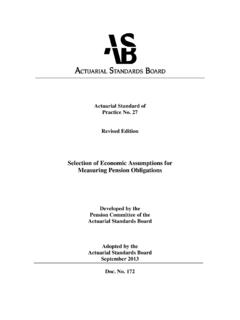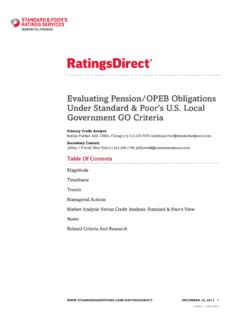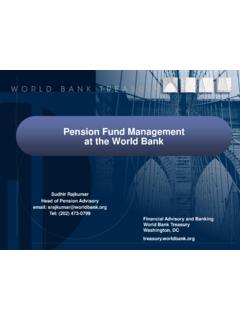Transcription of NASRA Issue Brief
1 February 2017 | NASRA Issue Brief : Public pension Plan Investment Return Assumptions | Page 1 Figure 1: Public pension Sources of Revenue, 1986-2015 Source: Compiled by NASRA based on Census Bureau data NASRA Issue Brief : Public pension Plan Investment Return Assumptions Updated February 2017 As of September 30, 2016, state and local government retirement systems held assets of $ These assets are held in trust and invested to pre-fund the cost of pension benefits. The investment return on these assets matters, as investment earnings account for a majority of public pension financing. A shortfall in long-term expected investment earnings must be made up by higher contributions or reduced benefits. Funding a pension benefit requires the use of projections, known as actuarial assumptions, about future events. Actuarial assumptions fall into one of two broad categories: demographic and economic.
2 Demographic assumptions are those pertaining to a pension plan s membership, such as changes in the number of working and retired plan participants; when participants will retire, and how long they ll live after they retire. Economic assumptions pertain to such factors as the rate of wage growth and the future expected investment return on the fund s assets. As with other actuarial assumptions, projecting public pension fund investment returns requires a focus on the long-term. This Brief discusses how investment return assumptions are established and evaluated, compares these assumptions with public funds actual investment experience, and the challenging investment environment public retirement systems currently face. Because investment earnings account for a majority of revenue for a typical public pension fund, the accuracy of the return assumption has a major effect on a plan s finances and actuarial funding level.
3 An investment return assumption that is set too low will overstate liabilities and costs, causing current taxpayers to be overcharged and future taxpayers to be undercharged. A rate set too high will understate liabilities, undercharging current taxpayers, at the expense of future taxpayers. An assumption that is significantly wrong in either direction will cause a misallocation of resources and unfairly distribute costs among generations of taxpayers. As shown in Figure 1, since 1986, public pension funds have accrued approximately $ trillion in revenue, of which $ trillion, or 63 percent, is from investment earnings. Employer contributions account for $ trillion, or one-fourth of the total, and employee contributions total $805 billion, or 12 1 Federal Reserve, Flow of Funds Accounts of the United States: Flows and Outstandings, Third Quarter 2016, Table 2 US Census Bureau, Annual Survey of Public Pensions, State & Local Data February 2017 | NASRA Issue Brief : Public pension Plan Investment Return Assumptions | Page 2 Figure 2: Annual change in contributions from prior year, corporate vs.
4 Public pensions Most public retirement systems review their actuarial assumptions regularly, pursuant to state or local statute or system policy. The entity responsible for setting the return assumption, as identified in Appendix B, typically works with one or more professional actuaries, who follow guidelines set forth by the Actuarial Standards Board in Actuarial Standards of Practice No. 27 (Selection of Economic Assumptions for Measuring pension Obligations) (ASOP 27), which prescribes the factors actuaries should consider in setting economic actuarial assumptions. ASOP 27 recommends that actuaries consider the context of the measurement they are making, as defined by such factors as the purpose of the measurement, the length of time the measurement period is intended to cover, and the projected pattern of the plan s cash flows. ASOP 27 also advises that actuarial assumptions be reasonable, defined in subsection as being consistent with five specified characteristics; and requires that actuaries consider relevant data, such as current and projected interest rates and rates of inflation; historic and projected returns for individual asset classes; and historic returns of the fund itself.
5 For plans that remain open to new members, actuaries focus chiefly on a long investment horizon, , 20 to 30 years, as this is the length of a typical public pension plan s funding period. One key purpose for relying on a long timeframe is to promote the key policy objectives of cost stability and predictability, and intergenerational equity among taxpayers. The investment return assumption used by public pension plans typically contains two components: inflation and the real rate of return. The sum of these components is the nominal return rate, which is the rate that is most often used and cited. The system s inflation assumption typically is applied also to other actuarial assumptions, such as the level of wage growth and, where relevant, assumed rates of cost-of-living adjustments (COLAs). Achieving an investment return approximately commensurate with the inflation rate normally is attainable by investing in securities, such as US Treasury bonds, that are considered to be risk-free, , that pay a guaranteed rate of return.
6 The second component of the investment return assumption is the real rate of return, which is the return on investment after adjusting for inflation. The real rate of return is intended to reflect the return produced as a result of the risk taken by investing the assets. Achieving a return higher than the risk-free rate requires taking some investment risk; for public pension funds, this risk takes the form of investments in assets such as public and private equities and real estate, which contain more risk than Treasury bonds. Unlike public pension plans, corporate plans are required by federal regulations to make contributions on the basis of current interest rates. As Figure 2 shows, this funding method results in plan costs that can be volatile and uncertain, often changing dramatically from one year to the next. This volatility is due partly to fluctuations in interest rates and has been identified as a leading factor in the decision among corporations to abandon their pension plans.
7 By contrast, by focusing on the long-term and relying on a stable investment return assumption, public plans experience less contribution volatility. February 2017 | NASRA Issue Brief : Public pension Plan Investment Return Assumptions | Page 3 Figure 3: Median public pension annualized investment returns for period ended 12/31/2016 Figure 3 plots median public pension fund annualized investment returns for a range of periods ended December 31, 2016. As the higher investment returns achieved in the 1980s and the 1990s are replaced by lower returns in more recent years, average annualized returns for longer periods, such as 20 and 25 years, have begun to decline gradually. The steep market declines of 2000-02 and 2008-09 have imposed a particularly negative effect for measurement periods that incorporate those events. In the wake of the 2008-09 decline in capital markets, and Great Recession, global interest rates and inflation have remained low by historic standards, due partly to so-called quantitative easing of central banks in many industrialized economies, including the Now in their eighth year, these low interest rates, along with low rates of projected global economic growth, have led to reductions in projected returns for most asset classes, which, in turn, have resulted in an unprecedented number of reductions in the investment return assumption used by public pension plans.
8 This trend is illustrated by Figure 4, which plots the distribution of investment return assumptions among a representative group of plans since 2001. Among the 127 plans measured, nearly three-fourths have reduced their investment return assumption since fiscal year 2010, resulting in a decline in the average return assumption from percent to percent. If projected returns continue to decline, investment return assumptions are likely to also to continue their downward trend. Appendix A lists the assumptions in use or adopted for future use by the 127 plans in this dataset. One challenging facet of setting the investment return assumption that has emerged more recently is a divergence between expected returns over the near term, , the next five to 10 years, and over the longer term, , 20 to 30 years3. A growing number of investment return projections are concluding that near-term returns will be materially lower than both historic norms as well as projected returns over longer timeframes.
9 Because many near-term projections calculated recently are well below the long-term assumption most plans are using, some plans face the difficult choice of either maintaining a return assumption that is higher than near-term expectations, or lowering their return assumption to reflect near-term expectations. 3 Horizon Actuarial Services, Survey of Capital Market Assumptions, 2016 Edition (July 2016) p4 Figure 4: Change in Distribution of Public pension Investment Return Assumptions, FY 01 to FY 18 February 2017 | NASRA Issue Brief : Public pension Plan Investment Return Assumptions | Page 4 If near-term rates indeed prove to be lower than historic norms, plans that maintain their long-term return assumption are likely to experience a steady increase in unfunded pension liabilities and corresponding costs.
10 Alternatively, plans that reduce their assumption in the face of diminished near-term projections will experience an immediate increase unfunded liabilities and required costs. As a rule of thumb, a 25 basis point reduction in the return assumption, such as from percent to percent, will increase the cost of a plan that has a COLA, by three percent of pay (such as from 10 percent to 13 percent), and a plan that does not have a COLA, by two percent of pay. Conclusion The investment return assumption is the single most consequential of all actuarial assumptions in terms of its effect on a pension plan s finances. The sustained period of low interest rates since 2009 has caused many public pension plans to re-evaluate their long-term expected investment returns, leading to an uprecedented number of reductions in plan investment return assumptions. Absent other changes, a lower investment return assumption increases both the plan s unfunded liabilities and cost.







